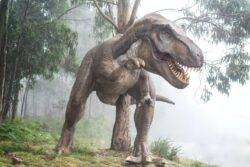Dinosaurs weren’t always so huge (Picture: Unsplash)
Dinosaurs weren’t always that big – some were barely the size of dogs. So how did they get so ginormous?
Scientists have found the missing link – air sacs that made their bones less dense, allowing them to grow to more than 30 metres in length. That’s equal to the size of two buses put together.
According to a recent study, these air sacs – or bone cavities – which are typical in present-day birds, enabled dinosaurs to capture more oxygen, keep their bodies cool and withstand the harsh conditions of their era.
Are you LGBTQIA+ and working in STEM?
Metro.co.uk and New Scientist Jobs have teamed up to conduct a global survey of LGBTQIA+ experiences in STEM industries, and we want to hear from you.
Click here to take part.
They also helped some of them become giants like the Tyrannosaurus rex and Brachiosaurus.
The study, published in the journal Anatomical Record, detailed how Macrocollum itaquii, the oldest dinosaur with these air sacs, helped solve the mystery.
The dinosaur was buried 225million years ago in what is now Agudo, a town in Rio Grande do Sul state, South Brazil.
Previous studies by the same team showed that the earliest fossils did not have air sacs (Picture: Unsplash)
‘M. itaquii was the largest dinosaur of its time, with a length of about three metres. A few million years before then, the largest dinosaurs were about 1 metre long. Air sacs certainly facilitated this increase in size,’ said lead author Tito Aureliano.
‘This was one of the first dinosaurs to walk the Earth, in the Triassic period,’ added co-author Fresia Ricardi-Branco.
‘The air sac adaptation enabled it to grow and withstand the climate in this period and later, in the Jurassic and Cretaceous. Air sacs gave dinosaurs an evolutionary advantage over other groups, such as mammals, and they were able to diversify faster.’
Previous studies by the same team showed that the earliest fossils did not have air sacs.
The vertebrae in which the air sacs were found also change what was known about the evolution of these structures. The authors found clear evidence of air sacs in the cervical and dorsal regions, with no sign of the structures in the abdominal region.
MORE : Dinosaur covered in blade-like spikes puts Isle of Wight back on the map
MORE : Scientists discover new dinosaur species, no bigger than a St Bernard
It’s thanks to something in present-day birds,





